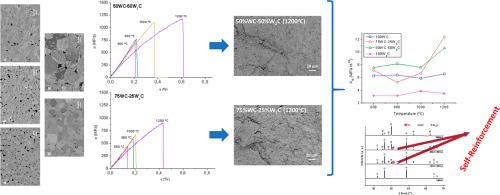International Journal of Refractory Metals & Hard Materials ( IF 4.2 ) Pub Date : 2021-04-29 , DOI: 10.1016/j.ijrmhm.2021.105565 E.M. Garcia-Ayala , S. Tarancon , B. Ferrari , J.Y. Pastor , A.J. Sanchez-Herencia

|
Metallic tungsten and tungsten carbide are some of the more relevant candidates proposed because of their high melting point, shielding capabilities and resistance to neutron damage. In this work, the microstructural and high temperature mechanical characterization of WC matrices with additions of 10, 20 and 50 vol% of W, dispersed by colloidal processing routes and sintered by Spark Plasma Sintering (SPS), are presented. Flexural elastic modulus, fracture strength and SENB toughness has been determined by the three-point bending tests at 600, 800, 1000 and 1200 °C.
Microstructural analysis shows that after SPS all the metallic tungsten has reacted to form W2C, and sintering process is able to stabilize phases corresponding to temperatures higher than achieved as a consequence of the additional energy provided by the method. Mechanical results indicated that resistance of all materials increases as the operating temperature increases. Furthermore, remarkably great results are obtained for the composition with 10 and 20 vol% of W. This macroscopic behaviour has been related to the microstructural decomposition of the metastable W2C, to WC and W, as temperature for the bending tests approach to the equilibrium temperature (1250 °C). It was found that the presence of metallic tungsten in the final microstructure could be the responsible of the plastic behaviour of the tested pieces at 1200 °C and the doubled value of the toughness.
中文翻译:

熔合条件下WC-W 2 C复合材料在第一壁的热力学行为
金属钨和碳化钨是一些更相关的候选物,因为它们具有高熔点,屏蔽能力和抗中子破坏性。在这项工作中,提出了通过添加10、20和50%的W(通过胶体加工路线分散并通过火花等离子烧结(SPS)烧结)的WC基质的微观结构和高温机械特性。弯曲弹性模量,断裂强度和SENB韧性已通过600、800、1000和1200°C下的三点弯曲测试确定。
显微组织分析表明,在SPS之后,所有金属钨都已反应形成W 2 C,并且由于该方法提供的额外能量,烧结工艺能够稳定对应于高于所达到温度的温度的相。力学结果表明,所有材料的电阻都随着工作温度的升高而增加。此外,对于具有10和20vol%的W的组合物,获得了显着的结果。这种宏观行为与亚稳W 2的微观结构分解有关。C为WC和W,因为弯曲试验的温度接近平衡温度(1250°C)。发现最终的显微组织中金属钨的存在可能是导致测试件在1200°C下的塑性行为和韧性值翻倍的原因。











































 京公网安备 11010802027423号
京公网安备 11010802027423号